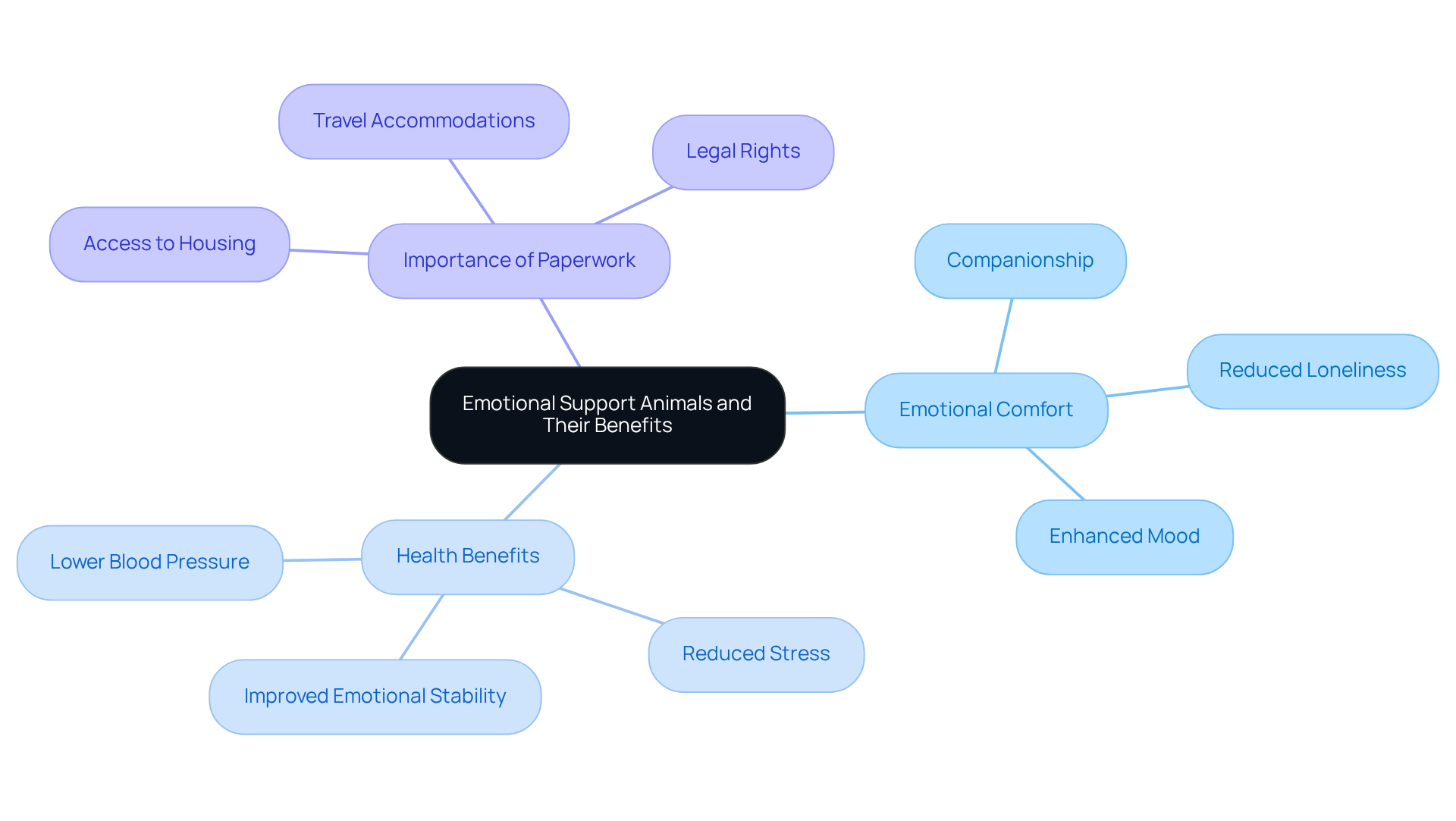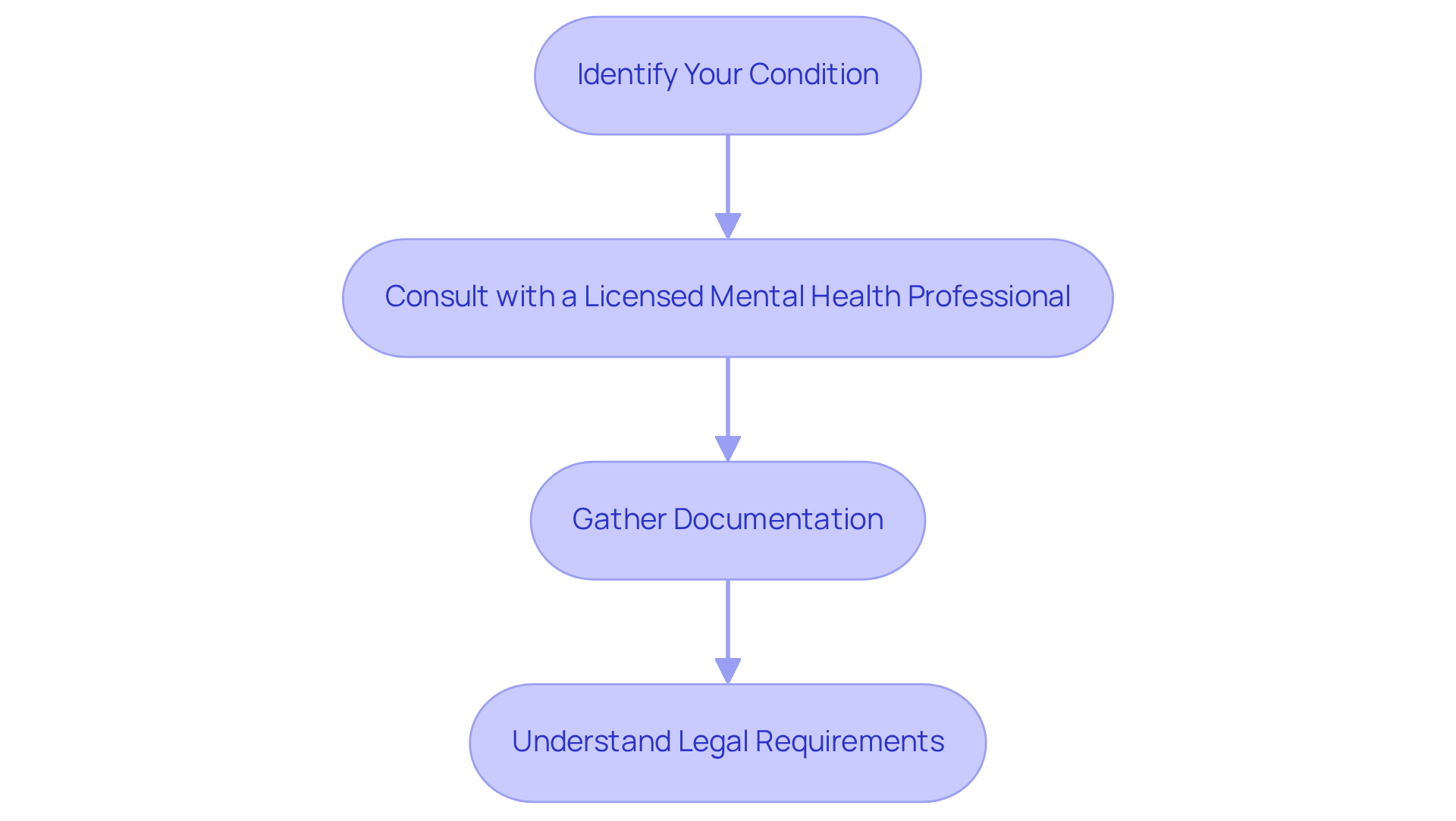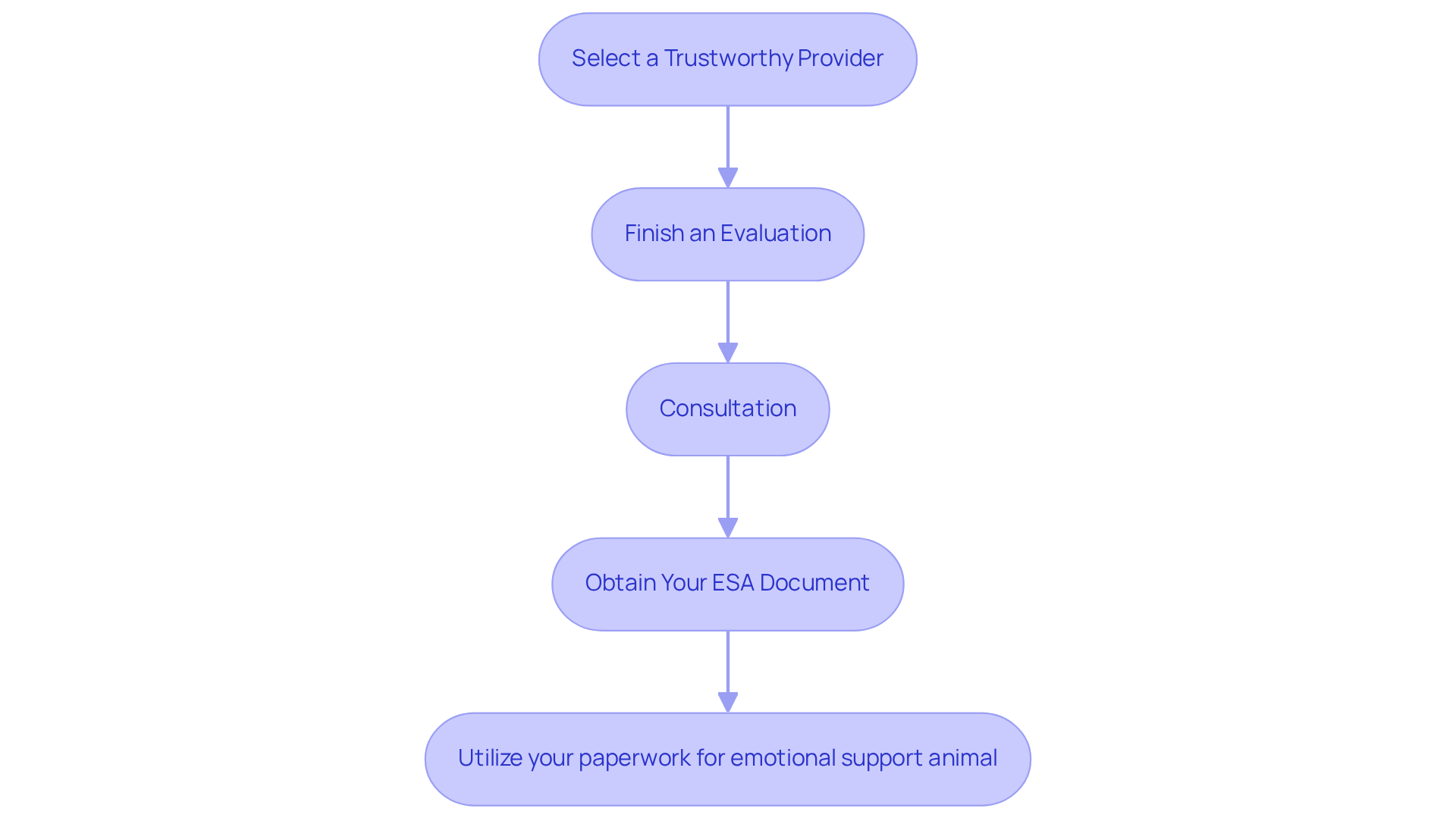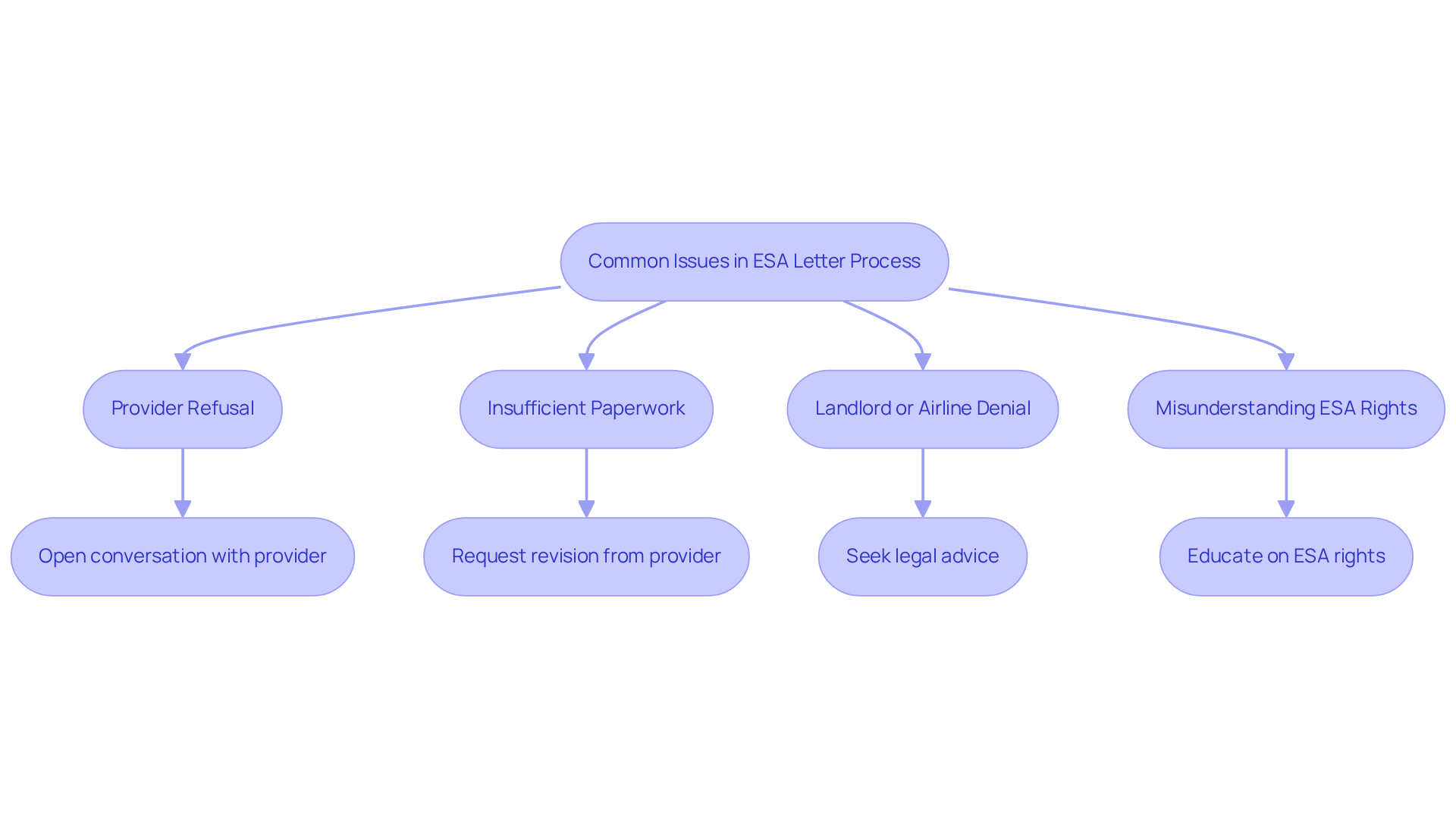

4 Steps for Paperwork for Emotional Support Animal Success
by Lena Park
Last updated: July 11, 2025
Verified and Approved by:
Angela Morris,
MSW, LCSW
Fact Checked

Overview
This article highlights four essential steps to help you navigate the process of obtaining the necessary paperwork for an Emotional Support Animal (ESA). It begins by recognizing the emotional challenges you may face due to your mental health condition.
- Identifying this condition is the first step, followed by consulting a licensed mental health professional who can provide the support you need.
- Gathering the right documentation is crucial, as it serves to validate your needs and secure your rights.
- Finally, understanding the legal requirements will empower you to advocate for yourself in housing and travel settings.
As you embark on this journey, it’s important to remember the positive impact that ESAs can have on mental well-being. Many individuals have experienced significant improvements in their emotional health with the companionship of an ESA. Proper documentation not only helps you secure necessary accommodations but also reinforces the bond between you and your support animal. You are not alone in this process; there is support available to help you every step of the way.
Introduction
Understanding the intricacies of Emotional Support Animals (ESAs) is vital for anyone seeking their companionship, particularly when faced with the necessary paperwork. These animals offer essential emotional support, aiding individuals in coping with various psychological challenges. However, the process of obtaining the required documentation can often feel overwhelming.
Have you ever wondered what steps are needed to ensure that an ESA can effectively fulfill its role? Or how one might overcome the common hurdles in securing the proper paperwork? This guide explores four essential steps to successfully navigate ESA documentation, empowering you to access the support you truly need.
Understand Emotional Support Animals and Their Benefits
Emotional Support Animals play an essential role in providing comfort and assistance to those grappling with emotional or psychological challenges. Unlike service animals, ESAs do not require specialized training; their primary purpose is to offer companionship, which can significantly alleviate feelings of loneliness and anxiety. Research shows that the presence of an ESA can lead to lower blood pressure, reduced stress levels, and enhanced emotional well-being. This highlights the importance of obtaining the necessary paperwork for emotional support animal to secure rights and access to housing and travel accommodations for ESA owners.
Emotional support is a vital aspect of what these animals provide. They offer unconditional love and companionship, helping to ease feelings of isolation. Have you ever felt the weight of loneliness? Interaction with an ESA has been shown to lower cortisol levels, contributing to decreased stress and anxiety. Many individuals report an improved mood and emotional stability when accompanied by an ESA, promoting a sense of safety and reducing feelings of isolation—especially beneficial for those facing mental well-being challenges.
Recent studies have underscored the effectiveness of educational support programs in enhancing mental health outcomes. For instance, a small study discovered that individuals with diagnosed mental conditions experienced a statistically significant reduction in depression and anxiety after obtaining an ESA. Mental wellness experts stress that ESAs can provide crucial emotional support, reinforcing the need for paperwork for emotional support animal to ensure their benefits are recognized in housing and travel situations.
Your journey towards emotional well-being is important, and the support of an ESA can be a compassionate solution. Remember, you are not alone in this experience; there are resources available to help you navigate these challenges.

Determine Eligibility for an ESA Letter
To qualify for an Emotional Support Animal (ESA) letter, individuals must demonstrate a mental condition that significantly impacts their daily life. Let’s explore the steps to determine eligibility, recognizing the emotional journey you may be on.
- Identify Your Condition: Many individuals face challenges such as anxiety disorders, depression, PTSD, and other emotional or psychological disabilities. Take a moment to reflect on how these conditions affect your daily functioning. Research has shown that 62% of ESA owners reported an improvement in their mental well-being during the pandemic, compared to just 19% of those without an ESA. Emotional support animals can provide essential comfort and alleviate symptoms, particularly for learners with disabilities, enhancing their ability to engage fully in both educational and social experiences.
- Consult with a Licensed Mental Health Professional: It’s crucial to schedule an appointment with a licensed therapist, psychologist, or psychiatrist. They will evaluate your mental well-being and determine if an ESA would be beneficial for you. It’s important to know that 70% of pet owners are unaware of how to have their pets certified as emotional support animals, highlighting the need for professional guidance in this process. As licensed mental wellness experts often say, “Understanding the certification process is essential for those seeking the emotional support that ESAs provide.” At Wellness Wag, we offer a streamlined online process for obtaining legitimate ESA letters through personalized consultations with licensed medical professionals.
- Gather Documentation: If your mental health professional agrees that an ESA is appropriate, they will provide documentation outlining your diagnosis and the necessity of an ESA for your treatment. This documentation is vital for accessing housing and travel accommodations under the Fair Housing Act and the Air Carrier Access Act. Statistics indicate that only 32% of pet owners have had their animals certified as emotional support animals, underscoring the importance of proper documentation. Wellness Wag’s assessment process is designed to tailor services to your needs, ensuring you have the necessary paperwork to support your journey.
- Understand Legal Requirements: Familiarizing yourself with the legal protections granted to emotional support animals can empower you to advocate for your rights. Under the Fair Housing Act, individuals with verified ESAs are entitled to live with their animals in pet-restricted housing, ensuring that your emotional support needs are met. If you have any questions or concerns about the ESA certification process, please refer to our FAQs or reach out to us directly for assistance. Remember, you are not alone on this journey, and support is available to help you navigate the process.

Follow the Steps to Obtain Your ESA Letter
Navigating the journey to obtain your Emotional Support Animal (ESA) letter can feel overwhelming, but with the right steps, you can find the support you need. Here’s how to approach this process with care:
-
Select a Trustworthy Provider: It’s important to choose a licensed mental wellness expert or a reputable online service known for providing ESA letters. Take the time to verify their adherence to legal standards and their solid reputation in the field; this choice is crucial for your peace of mind.
-
Finish an Evaluation: Most providers will require you to complete a brief evaluation designed to assess your mental well-being and confirm your eligibility for an ESA. This step is essential as it lays the groundwork for your consultation, ensuring that your needs are understood.
-
Consultation: Schedule a consultation with your chosen provider, where you can openly discuss your mental health condition and the supportive role an ESA can play in your treatment. Your honesty and thoroughness during this conversation are vital for an accurate evaluation, fostering a deeper connection with your provider.
-
Obtain Your ESA Document: If approved, your provider will issue your ESA document, typically within 24 hours. This document should be printed on official stationery, including your name, diagnosis, and the provider’s contact information. It’s important to ensure that it meets all legal requirements to be considered valid, providing you with the necessary support.
-
Utilize your paperwork for emotional support animal: With your paperwork for emotional support animal in hand, you can present it to landlords or airlines to secure the accommodations you need. Remember, many providers aim to deliver ESA documents swiftly, often within a day of approval, allowing you to focus on your well-being.
By following these steps, you can effectively navigate the process of acquiring the necessary paperwork for emotional support animal documentation. Remember, you are not alone in this journey; support is available to help enhance your emotional well-being.

Troubleshoot Common Issues in the ESA Letter Process
While obtaining paperwork for emotional support animal can often feel straightforward, it’s important to recognize that some individuals may encounter challenges along the way. Let’s explore these common issues together and consider compassionate solutions to address them.
-
Provider Refusal: If your mental wellness specialist seems hesitant to write an ESA document, it’s beneficial to have an open conversation about your needs. Take the time to clarify their concerns and share information about the positive impact of ESAs on mental health. Remember, many providers are willing to assist; understanding their perspective can lead to a more productive dialogue.
-
Insufficient paperwork for emotional support animal: It’s essential that your paperwork for emotional support animal includes all necessary details, such as your diagnosis, the provider’s license number, and their contact information. If your letter is rejected, don’t hesitate to ask your provider for a revision to meet the required standards. This proactive step can help ensure your needs are met.
-
Landlord or Airline Denial: Should your ESA letter be denied, it’s crucial to familiarize yourself with the legal requirements for ESA letters. Make sure your paperwork for emotional support animal aligns with these standards. If you continue to face challenges, consider seeking legal advice or support from organizations that specialize in ESA rights. They can offer invaluable assistance in navigating these obstacles.
-
Misunderstanding Emotional Support Animal Rights: Educating yourself on the rights associated with emotional support animals under the Fair Housing Act and the Air Carrier Access Act is vital. Understanding these rights empowers you to advocate for yourself effectively, ensuring you can access the support your ESA provides. Awareness of these regulations is essential, as many people may not realize their rights regarding ESAs.
By recognizing these challenges and exploring solutions together, we can foster a supportive environment that allows you to fully benefit from the companionship and comfort that an emotional support animal can provide.

Conclusion
Navigating the process of securing the necessary paperwork for an Emotional Support Animal (ESA) is crucial for those seeking comfort and companionship during challenging times. It’s important to recognize the emotional struggles that many individuals face. By understanding the role of ESAs and the profound benefits they provide, you can truly appreciate the importance of obtaining proper documentation to protect your rights in housing and travel situations.
The journey toward acquiring an ESA letter involves several key steps:
- Identifying your mental health condition
- Consulting with a licensed professional
- Gathering the right documentation
- Understanding the legal protections available to you
Each of these steps is designed to empower you, enabling you to advocate effectively for your emotional support needs. With professional guidance, you can navigate this process with confidence, leading to successful outcomes in obtaining your ESA documentation.
Ultimately, the message is clear: securing an ESA can significantly enhance your emotional well-being. Understanding the paperwork process is vital in this journey. If you find yourself struggling, it’s essential to take the initiative to explore your eligibility and seek out the support you deserve. Remember, with the right resources and knowledge, you can pave the way toward a more fulfilling and emotionally stable life, enriched by the companionship of an ESA.
Frequently Asked Questions
What is the primary role of Emotional Support Animals (ESAs)?
The primary role of Emotional Support Animals is to provide comfort and companionship to individuals facing emotional or psychological challenges, helping to alleviate feelings of loneliness and anxiety.
Do Emotional Support Animals require specialized training?
No, unlike service animals, Emotional Support Animals do not require specialized training.
What benefits do Emotional Support Animals provide?
Emotional Support Animals can lead to lower blood pressure, reduced stress levels, and enhanced emotional well-being, improving mood and emotional stability for their owners.
How do ESAs help with feelings of isolation?
ESAs offer unconditional love and companionship, which can ease feelings of isolation and promote a sense of safety, particularly for those struggling with mental health challenges.
Is there research supporting the effectiveness of ESAs?
Yes, research indicates that individuals with diagnosed mental conditions experience significant reductions in depression and anxiety after obtaining an ESA.
Why is it important to have paperwork for an Emotional Support Animal?
Obtaining the necessary paperwork for an Emotional Support Animal is important to secure rights and access to housing and travel accommodations for ESA owners.
What should individuals know about their journey towards emotional well-being with an ESA?
Individuals should know that the support of an Emotional Support Animal can be a compassionate solution, and there are resources available to help navigate emotional challenges.
Certify Your Emotional Support Animal Today

Why You Can Rely on Us?
At Wellness Wag, we believe your pet deserves care rooted in both science and compassion. Each article is carefully researched, written in clear language for pet owners, and then reviewed by qualified professionals to ensure the information is evidence-based, current, and practical for real-life care. Our goal is to help you feel confident in making informed decisions about your pet’s health and well-being.
Reviewed by
Angela Morris, MSW, LCSW
Angela is a licensed clinical social worker with 20 years of experience in patient advocacy and community mental health. She has assisted numerous clients with ESA evaluations and brings a deep understanding of disability accommodations, ensuring that all information is accurate, supportive, and practical.

Written by :
Lena Park
Last Updated :
July 11, 2025












